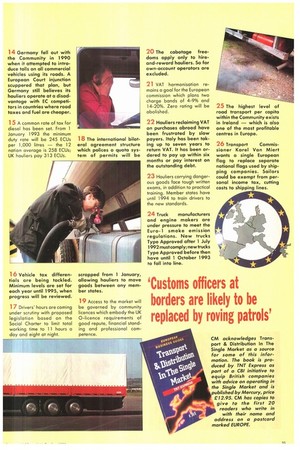The Maastricht Treaty for European economic union has its detractors
Page 36

Page 37

If you've noticed an error in this article please click here to report it so we can fix it.
but it will take more than a split French vote and the doughty Danes to stop the Single Market becoming reality on 1 January 1993. It is best to be prepared — here are some points to bear in mind 1 Trade barriers within the European Community cease to exist on 1 January 1993, giving unrestricted access within member states to 320 million customers.
Road haulage accounts for 87% of traffic by weight moved between EC member countries. This will increase at the expense of rail as hauliers' costs are harmonised across the Community.
3 Customs officers at borders are likely to be replaced by roving patrols which will have the authority to stop and spot-check vehicles within 50km of the point of departure or entry from a country. But concern over drug smuggling and terrorist activities may lead to some form of border checks remaining.
Freight movements within the EC are governed by the Single Administrative Document (SAD) and the Community Transit (1-Form) system. SAD will go — except for some traffic from Spain and Portugal which do not become members till 1995 — and use of the 1-form will diminish. Paperwork may be handled by a computerised direct trader input system (DTI) — allowing forward clearance of goods at ports.
5 Austria, Finland, Iceland, Norway, Sweden and Switzerland, who comprise the European Free Trade Association (EFTA), have removed customs barriers to EC trade and receive reciprocal freedoms within the EC.
tria imposing night-time bans and taxes to deter road haulage traffic, and Switzerland banning vehicles over 28 tonnes gross laden weight.
/ EFTA and the EC are at loggerheads on EC proposals to introduce an Alpine Transit corridor for trucks up to 40 tonnes with the Swiss and the Austrians insisting that freight should be moved across the Alps by rail. The EC warns that the rail link's capacity is inadequate.
8 Yugoslavia was willing to accept Community transit traffic, but that agreement is suspended until the political situation is stabilised.
9 The UK and Ireland are the only EC countries which have failed to agree harmonised vehicle weights for inter
national transport. The UK has stuck to 38 tonnes, although artic length limits rose from 15.5m to 16.5m in 1990 in line with the EC.
10 In the rest of the EC, trucks can operate at 40 tonnes on five or six axles, with some countries permitting 44 tonnes and Belgium and the Netherlands comfortable with 50 tonnes.
11 The UK is the only EC member which recovers every penny of its infrastructure costs from VED and fuel duty.
1 2 British hauliers pay 14 times more VED than the Italians.
1 3 Other member states are being asked to follow the British example on cost recovery. Transport Commissioner Karel Van Miert wants member states to implement their own road tax systems which would not be as high as a previous proposal of around 2,000 ECUs (22,700) a year. It is hoped this will placate the Germans.
Germany fell out with the Community in 1990 when it attempted to introduce tolls on all commercial vehicles using its roads. A European Court injunction scuppered that plan, but Germany still believes its hauliers operate at a disadvantage with EC competitors in countries where road taxes and fuel are cheaper.
A common rate of tax for diesel has been set. From 1 January 1993 the minimum duty rate will be 245 ECUs per 1,000 litres — the 12 nation average is 258 ECUs; UK hauliers pay 313 ECUs.
Vehicle tax differentials are being tackled. Minimum levels are set for each year until 1995, when progress will be reviewed.
I Drivers hours are coming
under scrutiny with proposed legislation based on the Social Charter to limit total working time to 11 hours a day and eight at night. scrapped from 1 January, allowing hauliers to move goods between any member states.
1 9 Access to the market will be governed by community licences which embody the UK 0-licence requirements of good repute, financial standing and professional competence.
The cabotage freedoms apply only to hireand-reward hauliers. So far own-account operators are excluded.
. VAT harmonisation remains a goal for the European commission which plans two charge bands of 4-9% and 14-20%. Zero rating will be abolished.
Hauliers reclaiming VAT on purchases abroad have been frustrated by slow payers. Italy has been taking up to seven years to return VAT. It has been ordered to pay up within six months or pay interest on the outstanding debt.
23 Hauliers carrying dangerous goods face tough written exams, in addition to practical training. Member states have until 1994 to train drivers to the new standards.
Truck manufacturers and engine makers are under pressure to meet the Euro-1 smoke emission regulations. New trucks Type Approved after 1 July 1992 must comply; new trucks Type Approved before then have until 1 October 1993 to fall into line. The highest level of road transport per capita within the Community exists in Ireland — which is also one of the most profitable centres in Europe.
Transport Commis sioner Karel Van Mient wants a single European flag to replace separate national flags used by shipping companies. Sailors could be exempt from personal income tax, cutting costs to shipping lines.




































































































